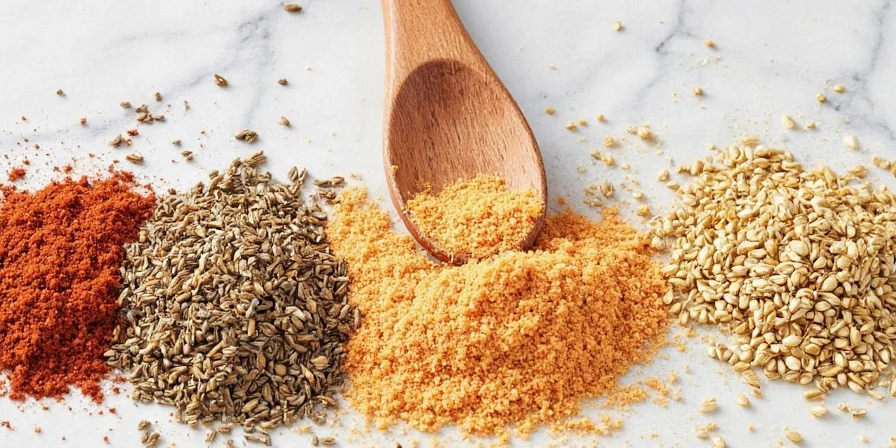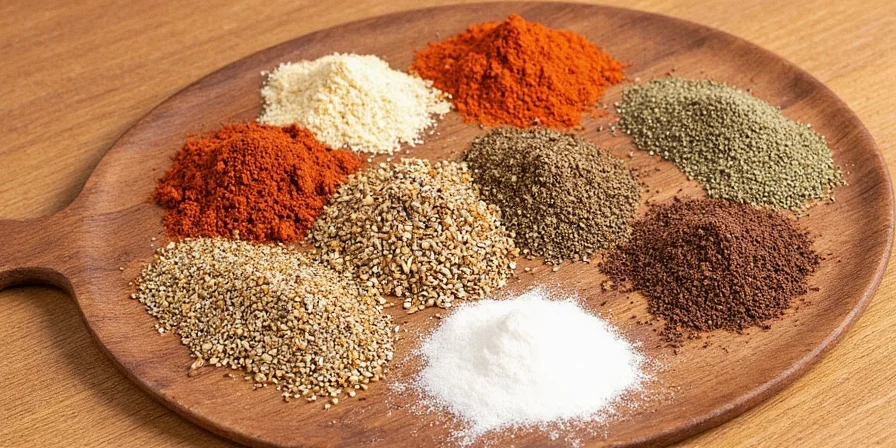Struggling with bland or inconsistent seasoning? You're not alone. Most home cooks make these 3 critical seasoning mistakes: adding salt too late, using spices at the wrong time, and not balancing flavors properly. The good news? Fixing these issues takes less than 5 minutes per meal and doesn't require special ingredients. Here's exactly how to make every dish taste professionally seasoned—starting with your next meal.
Professional chefs rely on these seasoning techniques because they work consistently, regardless of your cooking skill level. Forget complicated recipes—these practical methods focus on what actually matters: making your food taste delicious. You'll learn the precise timing for adding salt, when to use dried versus fresh herbs, and how to fix over-seasoned dishes (a trick most home cooks don't know).
This guide cuts through the confusion with step-by-step instructions anyone can follow. No culinary degree needed—just simple adjustments that transform ordinary meals into restaurant-quality dishes. Ready to never serve bland food again?
Table of Contents
- Salt Like a Pro: Timing & Amounts That Actually Work
- The Flavor Layering Method Home Cooks Miss
- When to Add Spices (The #1 Mistake Everyone Makes)
- Acid Secret: How to Brighten Dishes Without Making Them Sour
- Sweetness Hack for Spicy Foods That Actually Works
- The 30-Second Taste Test Chefs Use
- Toasting Spices Without Burning Them
- Umami Boosters That Make Cheap Ingredients Taste Expensive
- Why Fat Matters More Than You Think
- Personalize Your Seasoning for Your Taste Buds
- Quick Start Guide to Perfect Seasoning
1. Salt Like a Pro: Timing & Amounts That Actually Work

Salt isn't just for making food taste salty—it unlocks other flavors. The secret? Add 75% of your salt early, not at the end.
- For meats: Salt 45 minutes before cooking (not just before)
- For soups: Add salt in three stages (start, middle, finish)
- Simple rule: 1/2 teaspoon kosher salt per pound of food (adjust as you taste)
Stop guessing—this timing method prevents bland dishes and oversalting. Try it on your next chicken dinner and notice the difference immediately.
2. The Flavor Layering Method Home Cooks Miss

Restaurant-quality flavor comes from adding ingredients at the right time, not just using fancy ingredients. Here's when to add common seasonings:
| Seasoning Type | Best Time to Add | What Happens If Added Wrong |
|---|---|---|
| Salt | Early + during cooking | Late = uneven seasoning; too early = oversalted |
| Dried herbs | First 15 minutes of cooking | Added late = dusty flavor; too early = flavor lost |
| Fresh herbs | Last 2 minutes | Added early = bitter, cooked-out flavor |
This simple timing method creates depth that makes your food taste "restaurant-quality" without expensive ingredients.
3. When to Add Spices (The #1 Mistake Everyone Makes)
Adding spices at the wrong time wastes them. Here's what actually works:
- Dried spices: Bloom in oil first (30 seconds) before adding other ingredients
- Fresh herbs: Stir in during the last minute of cooking
- Garlic/ginger: Add after onions, before tomatoes
Why this matters: Heating spices in oil releases their flavor compounds. Add them directly to liquids and you lose up to 60% of the flavor. Try this with your next curry—you'll taste the difference immediately.
4. Acid Secret: How to Brighten Dishes Without Making Them Sour

Acid fixes bland food, but most home cooks add it wrong. The trick? Add acid in small increments at the END.
- Lemon juice: 1 teaspoon at a time, stir well, then taste
- Vinegar: Always reduce first to mellow harshness
- Tomato-based sauces: Add acid AFTER cooking completes
Pro tip: If you've oversalted a dish, a small splash of acid can balance it—try 1/4 teaspoon lemon juice per cup of soup.
5. Sweetness Hack for Spicy Foods That Actually Works
Sweetness tames heat without making food taste sweet. Better than just adding sugar:
- Honey works faster than sugar (add during final cooking stage)
- Carrots naturally sweeten spicy broths (add whole, remove later)
- 1/2 teaspoon maple syrup per cup balances heat without sweetness
Use this in your next chili or curry—add sweet elements AFTER the main cooking completes for best results.
6. The 30-Second Taste Test Chefs Use

Most home cooks taste wrong. Do this instead:
- Cool a small spoonful to room temperature
- Cleanse palate with plain cracker or bread
- Follow this tasting order: salt → acid → sweetness → heat
This sequence prevents flavor confusion. You'll immediately notice if something's missing—usually salt or acid.
7. Toasting Spices Without Burning Them
Burnt spices ruin dishes. Perfect toast every time:
- Use medium-low heat (no oil needed)
- Stir constantly for 60-90 seconds
- Remove from pan when you SMELL them (before they look done)
Test: Place a few grains on white paper—should leave oily spot when done. Never leave unattended!
8. Umami Boosters That Make Cheap Ingredients Taste Expensive

You don't need expensive ingredients for deep flavor. Try these affordable options:
- Soy sauce: 1 teaspoon in soups/pasta sauces (add late)
- Miso paste: Whisk into dressings or marinades
- Anchovies: Melt into tomato sauces (you won't taste fish)
- Mushroom powder: Substitute for 25% of salt in recipes
Pro tip: Add umami elements AFTER main cooking to preserve flavor.
9. Why Fat Matters More Than You Think
Fat carries flavor. Without enough fat, seasoning disappears. Simple fixes:
- Add 1 tablespoon olive oil to tomato sauces
- Finish soups with butter or cream (even non-dairy)
- Don't drain all fat from meats—use some for finishing
This is why "low-fat" dishes often taste bland—the seasoning has nothing to cling to.
10. Personalize Your Seasoning for Your Taste Buds

Everyone's taste buds differ. Find your sweet spot:
- Make a basic soup (chicken + water + salt)
- Add salt in 1/8 teaspoon increments
- Note when it tastes "just right" (usually 1/2-3/4 tsp per cup)
This becomes your personal salt baseline. Adjust all recipes from this point.
Quick Start Guide to Perfect Seasoning
Start with these 3 changes today for immediate improvement:
- Season meats 45 minutes before cooking (not just before)
- Add dried spices to hot oil first (30 seconds), THEN other ingredients
- Fix bland dishes with small acid additions at the END
Track your adjustments in a notes app for 7 days—you'll develop your personal seasoning rhythm. Within two weeks, you'll instinctively know when a dish needs more salt, acid, or umami. The key isn't more ingredients—it's using what you have at the right time. Stop following recipes blindly and start tasting as you go. Your food will never taste bland again.
Frequently Asked Questions
How do I fix oversalted food?
Add acid (lemon juice or vinegar) in 1/4 teaspoon increments—it balances saltiness without making food sour. For soups/stews, add raw potato chunks (remove after 15 minutes) which absorb excess salt. If possible, dilute with unsalted liquid. Never add sugar—it makes saltiness more noticeable.
What's the easiest seasoning mistake to fix?
Blandness is easiest to fix. Add salt in tiny increments while tasting, then finish with acid (lemon juice or vinegar). For most dishes, 1/4 teaspoon acid added at the end makes flavors pop. If you've added dried herbs too late, toast a small amount in oil and stir in at the end.
How can I season without measuring?
Use your fingers: pinch salt between thumb and forefinger—that's about 1/8 teaspoon. For soups, add seasoning until you can just detect it, then stop. When in doubt, under-season slightly—you can always add more later but can't remove excess. Practice makes perfect; after 10-15 meals, you'll develop instinct.
Why does restaurant food taste better seasoned?
Restaurants use three secrets: 1) They season in layers (not just at the end), 2) They use enough salt (most home cooks use 30-50% less than needed), and 3) They finish with acid. You can replicate this at home by salting early, using the tasting method described above, and adding a splash of lemon juice before serving.











 浙公网安备
33010002000092号
浙公网安备
33010002000092号 浙B2-20120091-4
浙B2-20120091-4